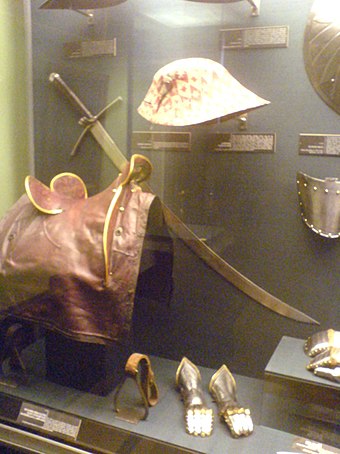This article needs additional citations for verification. (July 2021) |
| Messer | |
|---|---|
 A Kriegsmesser in the Kunsthistorisches Museum, Vienna. | |
| Type | Sword |
| Service history | |
| In service | 15th century – 16th century |
| Specifications | |
| Mass | 0.96–1.4 kg (2.1–3.1 lb) |
| Length | 75–113 cm (30–44 in) |
| Blade length | 62–85 cm (24–33 in) |
| Blade type | Single-edged |
| Hilt type | Cruciform and riveted, with end cap or pommel and nagel |
A messer (German for "knife") is a single-edged sword of the 15th and 16th century, characterised by knife-like hilt construction methods.
While the various names are often used synonymously, messers can be divided into several principal groups:
A Bauernwehr ("peasant's knife" or "peasant's sidearm") or Hauswehr ("home/household knife") is a single-handed knife, used for utility and defence. Typical blade lengths range from 15 cm (5.9 in) lengths up to around 35 cm (14 in).
Messer, Langes Messer, and Großes Messer ("knife", "long knife", and "great knife" respectively) are usually single-handed swords used for self-defence.[1] These blade lengths ranged from about 45 cm (18 in) to 90 cm (35 in). Hilts are normally suited to single handed use, but the larger examples may feature extended grips suitable for a second hand-hold.
Kriegsmesser ("war knife") are the largest examples of messer-hilted weapons, ranging from around 1 m (3 ft 3 in) long with approximately 80 cm (31 in) blade, up to around 1.35 m (4 ft 5 in) long with blades up to 1 m (3 ft 3 in) in length. Designed to be used with both hands, such messers were dedicated military arms, normally wielded by professional soldiers during the 15th and 16th century, such as the Landsknecht.
These names are subjective, and there are no known texts which clearly codify the differences between groups. As such, A large Bauernwehr might well have also been called a Messer, or a large Großes Messer might have been called a Kriegsmesser.
- ^ Archived at Ghostarchive and the Wayback Machine: "Langes Messer or long knife - the Germanic falchion-relation". YouTube.